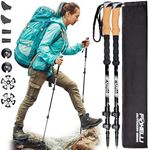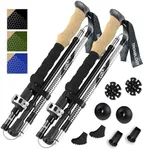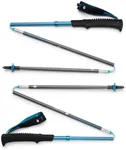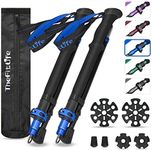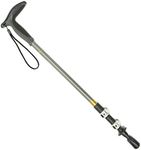Buying Guide for the Best Hiking Poles
Choosing the right hiking poles can significantly enhance your hiking experience by providing stability, reducing strain on your joints, and improving your balance. When selecting hiking poles, it's important to consider several key specifications to ensure you pick the best fit for your needs. Here are the main factors to consider and how to navigate them.MaterialThe material of hiking poles affects their weight, durability, and cost. Common materials include aluminum and carbon fiber. Aluminum poles are generally more durable and less expensive, but they are heavier. Carbon fiber poles are lighter and reduce fatigue over long distances, but they can be more expensive and less durable. If you prioritize durability and cost, aluminum might be the best choice. If you need lightweight poles for long hikes, consider carbon fiber.
AdjustabilityAdjustable hiking poles allow you to change their length to suit different terrains and your height. This is important for comfort and efficiency. Adjustable poles can be telescoping or folding. Telescoping poles are easy to adjust and sturdy, while folding poles are more compact and easier to pack. If you hike on varied terrain or share poles with others, adjustable poles are ideal. For those who prioritize compactness, folding poles are a great option.
Grip MaterialThe grip material of hiking poles affects comfort and sweat management. Common grip materials include cork, foam, and rubber. Cork grips conform to your hand shape over time and manage moisture well, making them comfortable for long hikes. Foam grips are soft and absorb sweat, providing comfort in hot conditions. Rubber grips are durable and provide a firm hold, but they can become slippery when wet. Choose cork or foam grips for comfort and moisture management, and rubber grips for durability.
WeightThe weight of hiking poles can impact your energy levels and fatigue over long hikes. Lighter poles are easier to carry and reduce fatigue, while heavier poles can provide more stability and durability. If you plan on long-distance hiking or have joint issues, lighter poles are preferable. For shorter hikes or rough terrain, heavier poles might offer better support.
Shock AbsorptionSome hiking poles come with shock absorption features, which can reduce the impact on your joints, especially on downhill sections. This is particularly important for those with joint issues or those planning to hike on hard surfaces. Shock-absorbing poles can be slightly heavier and more expensive. If joint protection is a priority, look for poles with shock absorption. If you prefer simplicity and lighter weight, non-shock-absorbing poles might be sufficient.
Locking MechanismThe locking mechanism of adjustable poles ensures they stay at the desired length. Common types include lever locks, twist locks, and push-button locks. Lever locks are easy to adjust and very secure, twist locks are lighter but can be less reliable, and push-button locks are simple and quick to use. If you need quick and secure adjustments, lever locks are ideal. For those who prefer lightweight options, twist locks might be suitable.
Basket SizeThe basket at the bottom of the pole prevents it from sinking into soft ground. Larger baskets are useful for snow or muddy conditions, while smaller baskets are better for rocky or hard-packed trails. If you hike in varied conditions, consider poles with interchangeable baskets. For specific environments, choose the basket size that matches the terrain you will encounter most often.


